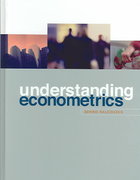Question
For data to use in these exercises, go to the Federal Reserve Bank of St. Louis FRED database atfred.stlouisfed.org. 1. Graph the main expenditure components
For data to use in these exercises, go to the Federal Reserve Bank of St. Louis FRED database atfred.stlouisfed.org.
1. Graph the main expenditure components of GDP (consumption, investment, government consumption expenditures and gross investment, exports, and imports), in real terms, since the first quarter of 1947. Also graph the expenditure components as a share of total real GDP. Do you see any significant trends?
2. On the same figure, graph national saving and investment as fractions of GDP, using quarterly U.S. data since 1947. (Note that national saving is called gross saving in the FRED database.) How does the behavior of these variables in the past ten years compare to their behavior in earlier periods? How is it possible for investment to exceed national saving, as it does in some periods?
3. If the real interest rate were approximately constant, then in periods in which inflation is high, the nominal interest rate should be relatively high (because the nominal interest rate equals the real interest rate plus the inflation rate). Using annual data since 1948, graph the three-month Treasury bill interest rate (FRED variable TB3MS, 3-Month Treasury Bill: Secondary Market Rate) and the CPI inflation rate for the U.S. economy. (Take annual averages of monthly interest rates and measure annual inflation rates as the change in the CPI from December to December.) Is it generally true that nominal interest rates rise with inflation? Does the relationship appear to be one-for-one (so that each additional percentage point of inflation raises the nominal interest rate by one percentage point), as would be the case if the real interest rate were constant? Calculate the real interest rate and graph its behavior since 1948.
4. A technological breakthrough raises a country's total facetor productivity A by 10%. Show how this change affects the graphs of both the production function relating output to capital and the production function relating output to labor.
5. Show that a 10% increase in A also increases the MPK and the MPN by 10% at any level of capital and labor?
6. Can a beneficial supply shock leave the MPK and MPN unaffected? Show your answer graphically.
Step by Step Solution
There are 3 Steps involved in it
Step: 1

Get Instant Access to Expert-Tailored Solutions
See step-by-step solutions with expert insights and AI powered tools for academic success
Step: 2

Step: 3

Ace Your Homework with AI
Get the answers you need in no time with our AI-driven, step-by-step assistance
Get Started


